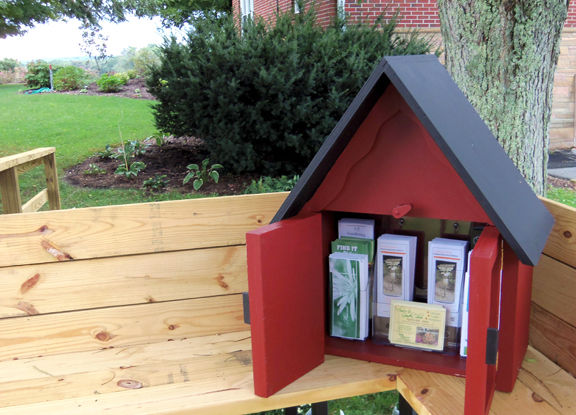Come see these shrubs in person. The various themed gardens and trial gardens within the University of Tennessee Gardens-Crossville/ Plateau Discovery Gardens complex are open for self-guided tours daily during daylight hours. Call to arrange group tours. Entry and parking behind the office are available without charge. Stop at the new Gathering Area/ Deck to pick up the latest informational brochures. Plateau Discovery Gardens is located a few miles south of I40 exit 311 Plateau Rd., off Hwy 70N at the University of Tennessee Plateau AgResearch and Education Center, 320 Experiment Station Rd., (931) 484-0034.
Master Gardener Carol Burdett, narrator of the 2014 video "Shrubs at Discovery Gardens" (accessible at the website www.CCMGA.org by clicking ‘our Videos’ on the bottom-right), also masterminded the first Plateau Discovery Gardens demonstration garden. That 2005 tree and shrub bed contains many evergreens/conifers.
Detailed information about specimens introduced in the video (continuation from last week):
3. Rheingold Arborvitae, Thuga occidentalis ’Rheingold’; zones 2-7; Full Sun, Part Shade (in afternoon); slow growing dwarf cultivar 3-5 feet H x same W; dome-shaped mound; prefers average to moist, well-drained soil, does not tolerate dry conditions; scale-type foliage in flat fan-shaped clusters of bright gold with orange tips in spring, yellow-gold in summer and turns bronze-gold in winter; shelter from cold winds to prevent winter burn; no serious insect or disease problems. 4. Green Lustre Holly, Ilex crenata ‘Green Lustre’, also called Japanese holly; broadleaf evergreen not needled; shiny dark green leaves similar to boxwood foliage; zones 6-9; Full Sun, Part Sun; acidic or neutral, needs well-drained soil; 3-4 feet H x 3-5 feet W; low mound that is compact and takes pruning well; if site is hot, dry and windy may see leaf scorch and mite problems. 5. Procumbins Nana groundcover juniper aka dwarf Japanese juniper; zones 4-9; loves Sun tolerates Part Sun; any soil; six inches H x 2 feet wide; stiff, aromatic needles, blue-green in summer developing purple tinge in autumn; popular for bonsai. 6. Blue star juniper/ single seed juniper, zones 5-8; Full Sun, Part Sun; slow growth to three feet H & W (about one foot high after five years); stiff, silver-blue foliage; prefers moist, well-drained soil, tolerates shallow, rocky soil; deer resistant. 7. Grey Owl juniper, Junperus virginiana ‘Grey Owl’; 2-9; Full Sun; slow-growing to three feet H x six feet W; silver gray foliage; average, well-drained soil, drought tolerant; deer resistant; berry-like cones attract birds. 8. Hinoki falsecypress, Chamaecyparis obtusa various cultivars; zones 4-8; Full Sun, Part Shade; slow growing, size and form depends upon variety; neutral to acidic well-drained soil a must, does not tolerate wet sites; dense, foliage with interesting texture caused by leaf pairs of different size; foliage color varies by cultivar. 9. Boulevard Pom Pom falsecypress/ Sawara falsecypress, Chamaecyparis pisifera ‘Boulevard’; zones 4-8; Full Sun, Part Sun; prefers moist, well-drained soil; slow growing 6-10 feet H x 3 feet W; compact upright conifer; soft, blue-green needles are purple-tinged in winter; prune into pom pom form; prefers moist, well-drained loam soil; protect from winter winds. 10. Glubosa blue spruce, Picea pungens ‘Glauca Globosa’; zones 2-7; Full Sun; acidic, well-drained soil; 3-5 feet H x 4-6 feet W; dwarf, globe-shaped; stiff, bristly blue needles; dislikes high heat & humidity; tolerates rabbits, deer, drought, pollution. 11. Bird’s nest spruce, Picea abies ‘Nidiformis’; zones 3-7; Full Sun; average, moist, well-drained soil; slow-growing conifer with depression in flattened top that looks like a nest; 3-8 feet H x 3-12 feet W; thin dark needles. 12. Blue rug juniper, Juniperus horizontalis ‘Wiltonii’; zones 3-8; Full Sun, Part Shade; fast growing creeping groundcover 4-6 inches H x 6-8 feet W; green to silver-blue foliage; needs good drainage; a Canadian native which tolerates poor, sandy, dry and rocky soil.
• • •
"Plateau Gardening" written by Master Gardeners for gardeners in Tennessee’s Upper Cumberland Region. Contact UT Extension Cumberland County at P.O. Box 483, Crossville, TN 38557 (484-6743) answers to horticulture questions, free publications and to learn about the Master Gardener program. Send email comments or yard & garden inquiries to Master Gardener Rae (MGardenerRae@frontiernet.net).

















Commented
Sorry, there are no recent results for popular commented articles.